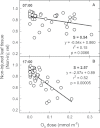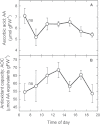Demonstration of a diel trend in sensitivity of Gossypium to ozone: a step toward relating O₃ injury to exposure or flux
- PMID: 23404900
- PMCID: PMC3617835
- DOI: 10.1093/jxb/ert032
Demonstration of a diel trend in sensitivity of Gossypium to ozone: a step toward relating O₃ injury to exposure or flux
Abstract
Plant injury by ozone (O3) occurs in three stages, O3 entrance through stomata, overcoming defences, and attack on bioreceptors. Concentration, deposition, and uptake of O3 are accessible by observation and modelling, while injury can be assessed visually or through remote sensing. However, the relationship between O3 metrics and injury is confounded by variation in sensitivity to O3. Sensitivity weighting parameters have previously been assigned to different plant functional types and growth stages, or by differentially weighting O3 concentrations, but diel and seasonal variability have not been addressed. Here a plant sensitivity parameter (S) is introduced, relating injury to O3 dose (uptake) using three independent injury endpoints in the crop species, Pima cotton (Gossypium barbadense). The diel variability of S was determined by assessment at 2h intervals. Pulses of O3 (15 min) were used to assess passive (constitutive) defence mechanisms and dose was used rather than concentration to avoid genetic or environmental effects on stomatal regulation. A clear diel trend in S was apparent, with maximal sensitivity in mid-afternoon, not closely related to gas exchange, whole leaf ascorbate, or total antioxidant capacity. This physiologically based sensitivity parameter provides a novel weighting factor to improve modelled relationships between either flux or exposure to O3, and O3 impacts. This represents a substantial improvement over concentration- or phenology-based weighting factors currently in use. Future research will be required to characterize the variability and metabolic drivers of diel changes in S, and the performance of this parameter in prediction of O3 injury.
Figures








Similar articles
-
Diel trends in stomatal response to ozone and water deficit: a unique relationship of midday values to growth and allometry in Pima cotton?Plant Biol (Stuttg). 2016 Jan;18 Suppl 1:37-46. doi: 10.1111/plb.12355. Epub 2015 Jun 25. Plant Biol (Stuttg). 2016. PMID: 26031549
-
Leaf traits and photosynthetic responses of Betula pendula saplings to a range of ground-level ozone concentrations at a range of nitrogen loads.J Plant Physiol. 2017 Apr;211:42-52. doi: 10.1016/j.jplph.2017.01.002. Epub 2017 Jan 16. J Plant Physiol. 2017. PMID: 28152417
-
The ozone sensitivity of five poplar clones is not related to stomatal conductance, constitutive antioxidant levels and morphology of leaves.Sci Total Environ. 2020 Jan 10;699:134402. doi: 10.1016/j.scitotenv.2019.134402. Epub 2019 Sep 10. Sci Total Environ. 2020. PMID: 31683210
-
Linking exogenous foliar application of glycine betaine and stomatal characteristics with salinity stress tolerance in cotton (Gossypium hirsutum L.) seedlings.BMC Plant Biol. 2021 Mar 20;21(1):146. doi: 10.1186/s12870-021-02892-z. BMC Plant Biol. 2021. PMID: 33743608 Free PMC article.
-
Detoxification and repair process of ozone injury: from O3 uptake to gene expression adjustment.Environ Pollut. 2009 May;157(5):1461-9. doi: 10.1016/j.envpol.2008.09.029. Epub 2008 Oct 26. Environ Pollut. 2009. PMID: 18954925 Review.
Cited by
-
Functional Leaf Traits and Diurnal Dynamics of Photosynthetic Parameters Predict the Behavior of Grapevine Varieties Towards Ozone.PLoS One. 2015 Aug 13;10(8):e0135056. doi: 10.1371/journal.pone.0135056. eCollection 2015. PLoS One. 2015. PMID: 26270333 Free PMC article.
-
The response of marigold (Tagetes erecta Linn.) to ozone: impacts on plant growth and leaf physiology.Ecotoxicology. 2017 Jan;26(1):151-164. doi: 10.1007/s10646-016-1750-7. Epub 2016 Dec 15. Ecotoxicology. 2017. PMID: 27981402
References
-
- Amiro BD, Gillespie TJ, Thurtell GW. 1984. Injury response to Phaseolus vulgaris to ozone flux density. Atmospheric Environment 18, 1207–1215
-
- Avnery S, Mauzerall DL, Liu J, Horowitz LW. 2011a. Global crop yield reductions due to surface ozone exposure: 1. Year 2000 crop production losses and economic damage. Atmospheric Environment 45, 2284–2296
-
- Avnery S, Mauzerall DL, Liu J, Horowitz LW. 2011b. Global crop yield reductions due to surface ozone exposure: 2. Year 2030 potential crop production losses and economic damage under two scenarios of O3 pollution. Atmospheric Environment 45, 2297–2309
-
- Barnes J, Zheng U, Lyons T. 2002. Plant resistance to ozone: the role of ascorbate. In: Omasa K, Saji H, Youssefian S, Kondo N, eds. Air pollution and plant biotechnology—prospects for phytomonitoring and phytoremediation. Tokyo: Springer, 235–252
-
- Betzelberger AM, Gillespie KM, McGrath JM, Koester RP, Nelson RL, Ainsworth EA. 2010. Effects of chronic elevated ozone concentration on antioxidant capacity, photosynthesis and seed yield of 10 soybean cultivars. Plant, Cell and Environment 33, 1569–1581 - PubMed
MeSH terms
Substances
LinkOut - more resources
Full Text Sources
Other Literature Sources
Medical

